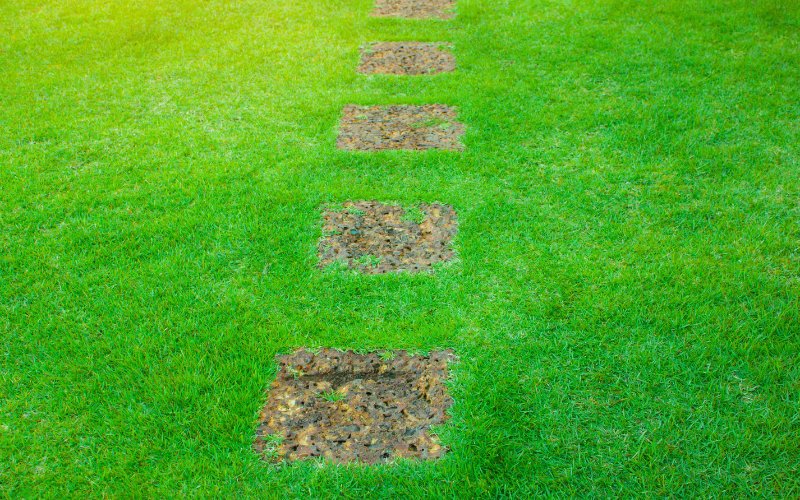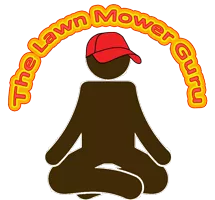I was driving to my friend’s house the other day and when I turned onto his street I notice his lawn was the only one still green and dense this late in summer. When I pulled up I immediately asked him what his secret was.
He told me he switched to zoysia grass a couple of years ago and the results have been incredible. Pretty soon we each had a beer in hand and he began rattling off the pros and cons of zoysia grass.

An Overview of Zoysia Grass Pros and Cons
There are a ton of benefits to having this on your lawn and the list of zoysia grass pros and cons is long. This turf is a transitional grass meaning it tolerates cold and is extremely heat and drought resistant.
The blades of this grass are so tough that they can handle moderate to heavy traffic and heal quickly with adequate watering. Once established, zoysia grass is low maintenance and will remain green even during a drought. These are just a few of zoysia grass’ benefits.
No grass is completely without drawbacks and zoysia grass is no different. Some disadvantages of zoysia grass can be its slow spreading habit and the growth stunting effect shade can cause.
As far as turf “greenness” goes, zoysia is on the lighter and less lush side and it is difficult to establish by seed. The tough blades can dull mowers quickly and once the cold sets in, zoysia grass turns brown.
| Pros | Cons |
|---|---|
| Tolerates cold | Spreads slowly/Growth stunted by shade |
| Drought resistant | Green is light and not vibrant |
| Tolerant of traffic | Difficult to get established from seed |
| Low maintenance | Dulls mower blades quickly |
| Remains green during drought | Browns in winter |
Advantages of Zoysia Grass
Brought to America from Asia in the 1900s, zoysia grass quickly became a favorite for lawns and golf courses all across the nation. It is hardy, diverse, climate tolerant, and can handle active children and pets continuously using it.
The advantages of zoysia make it one grass that has to be considered when choosing turf for your lawn. Check out the main zoysia grass pros below.
Tolerates Cold
Zoysia falls under the category of warm-season grass and comes with the reputation of handling high heat well. But unlike other summer grasses, this turf can handle cold snaps and winter weather with no trouble.
Its cold hardiness also gives it the benefit of staying green longer into the fall and lets it recover from early season frosts.
Drought Resistant
A warm-season grass typically has the ability to survive harsh, dry summers. Zoysia grass takes it one step further and remains green through a drought. This turf only needs .5 inches of rain a week to survive, but thrives and stays green with as little as 1”.
With a little supplemental watering during the hottest part of the summer, you can keep your zoysia grass turf greener than your neighbor’s lawn for a fraction of the cost!
Tolerant of Traffic
The best part about summer is that you can finally use your lawn. However, activities like walking, running, and playing can leave a heat-stressed lawn trashed. Fortunately, zoysia grass is a beast of a turf and can deal with heavy traffic use all summer long.
All this turf needs is an infrequent deep watering and it will bounce back from even the toughest use.
Low Maintenance
Zoysia grass spreads by stolons which grow slowly but form very dense turf once established. This thick growth gives weeds no chance to grow and helps immensely with water retention. The deep roots grow aggressively and can draw water directly from the table.
Once zoysia grass has achieved its dense growth, maintenance is reduced to almost nothing.
Remains Green in Drought
The grasses that are usually able to survive the cold winters can’t quite handle the summer’s heat. Zoysia grass can do both!
With a deep, infrequent, watering schedule and a feeding of 1lb nitrogen per 1K Sqft, you can keep your grass green through every heat wave and scorcher the summer throws your way.
Disadvantages of Zoysia Grass
Every grass has its limitations and the zoysia cons may make it unsuitable for your lawn needs. If you need a thick, dark green lawn fast, then you will want to look at other options. If you don’t like maintaining your mowing equipment or find regular yard trimming a chore, then the disadvantages might outweigh zoysia grass’ pros.
To make sure this really is the best turf for your lawn, check out all of the grass’ drawbacks below.
Spreads Slowly/Growth Stunted by Shade
Zoysia grass expends a lot of energy on building tough and resilient blades that can handle harsh climates and continuous foot traffic. This doesn’t happen quickly in the best of conditions and can be slowed by unfavorable circumstances.
While a mature lawn can handle shade, a young turf may be stunted if exposed to shade for too many hours during the active growing season.
This growth can further be slowed by a build-up of thatch that can prevent fertilizer and moisture from reaching the roots.
Green Is Light and Not Vibrant
Some people prefer a dark green, lush lawn and will use as much water and nutrients as needed to achieve it.
Zoysia grass makes great use of available fertilizer and water but tends to be a lighter green that never reaches the deep greens of other turfs. If your lawn is meant to be seen not used, then there may be better turfs out there for you.
Difficult to Establish from Seed
The slow growth of zoysia grass makes starting it from seed a very slow and sometimes difficult endeavor. Even with the right conditions, this grass will take a while to become dense and resistant to drought and cold.
To establish a lawn of zoysia grass quickly, you will need to spend extra for sod or plugs and still wait for it to establish a deep root system. If you are in a hurry to have a rich, thick lawn, you might need to look elsewhere.
Dulls Mower Blades Quickly
The strong stolons of zoysia grass create a dense mat that retains moisture and snuffs out weeds. It also makes mowing a pain. If you let this turf grow too high, it will need to be dethatched to prevent permanent damage. To prevent this, you need to keep it mowed to around 1” high.
Frequent mowing of such a tough grass can dull mower blades and require more frequent maintenance of your lawn mower. These added costs and frustrations might be a reason to consider other grasses.
Browns in Winter
Although zoysia can stay green through droughts and can survive the winter, it does go dormant at a certain point in the season.
When this happens, the grass’ attractive light green will turn to an unappealing brown. Your lawn will look dead for the few months of cold winter before it starts to green again in mid-late spring.
If you desire a lawn that is always green, you’ll need to find another turf.
Weighing Up Whether Zoysia Grass is Right for Your Yard
The pros and cons of zoysia grass are many and need to be carefully considered before choosing this turf for your lawn. If the pros of this grass make it a good choice, then you will need to make sure the cons will not come back to haunt you. To recap, the zoysia grass pros and cons are:
If you have hot, dry summers, early frosts with cold winters, and love to use your lawn then zoysia grass is a great option. This grass is low maintenance from the watering and fertilizing standpoint, and can stay green through a drought-plagued summer.
If you need a lawn that can establish quickly, from seed, and eventually achieves a dark green hue, then zoysia might not be your best choice. It can dull your equipment and will brown through the winter, making it undesirable for lawn owners that crave 4 seasons of green.
If you like zoysia grass’ benefits but the disadvantages make it a no-go, check out some of the turf alternatives below:
Buffalo Grass: This is a great grass if you want a darker lawn that grows quickly and never needs to be dethatched. It is especially good if you plan to rarely use your lawn and don’t have much shade coverage.
Red Fescue: Similar to zoysia in hardiness, this grass is ideal if you desire a green lawn all year round without frequent use of fertilizer or herbicides.
Bermuda Grass: This grass grows fast, can handle frequent use, and deals with drought with ease. It can grow on subpar soils, but you may have to compete with weeds and patchy growth with frequent mowing.


Great advice on Zoysia grass. Learned a lot about the sod I just planted. Looking forward to the next few years and seeing how this type of grass will do in this part of the country. (San Antonio, Tx)
Hi AJ,
I’m glad you found the article informative. Just remember that San Antonio, Texas, can have a challenging climate for maintaining a healthy lawn due to its hot and dry summers, frequent droughts, and occasional freezes in the winter. So, compared to other places in the States, you really have to be on your game.
If you keep on top of the following points, you should have a lovely lawn for many years to come.
Water deeply but infrequently
Mow at the right height
Fertilize when needed
Keep on top of weed control
Aerate and dethatch as needed
Thanks for the comment.
Tom.
Very informative, I just put out Zoysia Grass in my yard in a small area in my back yard. Wish I had seen this beforehand, but I do like the Zoysia Grass. My problem is I have varied areas of my yard that get sun and some that have many trees providing shade. So, I am going to have to think about what to use so this will be very helpful. Thanks!
Hi Barbara,
You’re welcome! I’m glad to hear that the information was helpful.
Zoysia grass is a great choice for many yards because it is drought-resistant, pest-resistant, and can tolerate a wide range of temperatures. However, it does need a lot of sunlight to grow properly. If you have areas of your yard that are heavily shaded by trees, you may need to consider using a different type of grass or ground cover in those areas.
Some good options for shaded areas include:
Fine fescue: Fine fescue is a cool-season grass that is shade-tolerant and drought-resistant. It grows well in areas with filtered sunlight or partial shade.
St. Augustine grass: St. Augustine grass is a warm-season grass that is also shade-tolerant. It does well in areas with partial shade, but it may not grow as well in areas with deep shade.
Perennial ryegrass: Perennial ryegrass is a cool-season grass that is regularly used as a temporary ground cover in areas with heavy shade. It germinates quickly and can help stabilize soil while other types of grasses or ground covers are being established.
Unfortunately, you didn’t mention where you are located, so I can’t be more specific on which grass type would work best for your area. Just make sure you pick a grass suited to either warm/cool/transition relevant to where you live.
Thanks for the question.
Tom.
Is it worth planting Zosya grass seeds in McCordsville, Indiana, zone 6, on top of already established different types of grass?
Hi Rafael,
Thanks for your question!
As for planting Zoysia in zone 6—it can work, but it’s really right at the edge of its range. It will likely go dormant earlier in the fall and green up later in the spring compared to cool-season grasses that are better suited to your area. That said, there are different varieties of Zoysia, and some may perform better than others in zone 6.
All that aside, in your specific case, it might not be the best choice. Zoysia is pretty slow to establish from seed and needs space to spread, so your existing grass would probably outcompete it. That’s just my gut feeling, though.
Hope that helps!
Tom.